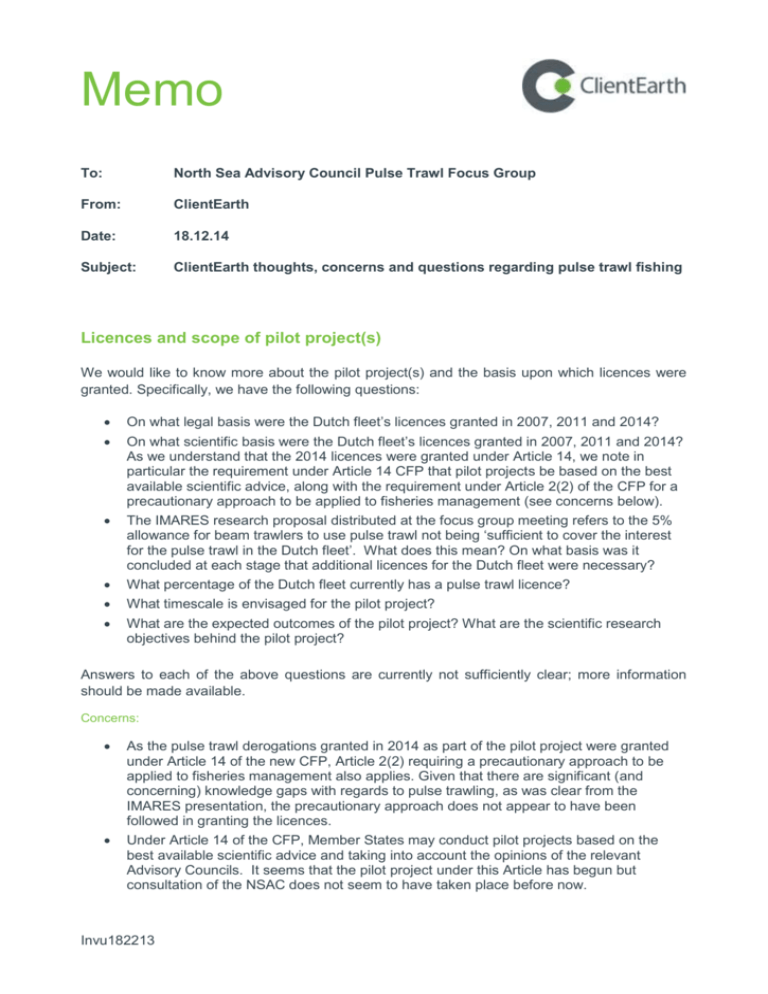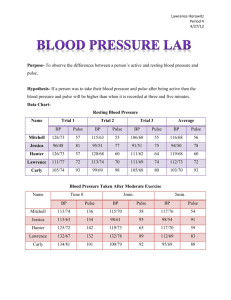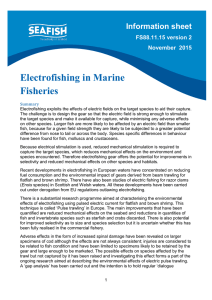Pulse Trawling Comments Client Earth
advertisement

Memo To: North Sea Advisory Council Pulse Trawl Focus Group From: ClientEarth Date: 18.12.14 Subject: ClientEarth thoughts, concerns and questions regarding pulse trawl fishing Licences and scope of pilot project(s) We would like to know more about the pilot project(s) and the basis upon which licences were granted. Specifically, we have the following questions: On what legal basis were the Dutch fleet’s licences granted in 2007, 2011 and 2014? On what scientific basis were the Dutch fleet’s licences granted in 2007, 2011 and 2014? As we understand that the 2014 licences were granted under Article 14, we note in particular the requirement under Article 14 CFP that pilot projects be based on the best available scientific advice, along with the requirement under Article 2(2) of the CFP for a precautionary approach to be applied to fisheries management (see concerns below). The IMARES research proposal distributed at the focus group meeting refers to the 5% allowance for beam trawlers to use pulse trawl not being ‘sufficient to cover the interest for the pulse trawl in the Dutch fleet’. What does this mean? On what basis was it concluded at each stage that additional licences for the Dutch fleet were necessary? What percentage of the Dutch fleet currently has a pulse trawl licence? What timescale is envisaged for the pilot project? What are the expected outcomes of the pilot project? What are the scientific research objectives behind the pilot project? Answers to each of the above questions are currently not sufficiently clear; more information should be made available. Concerns: As the pulse trawl derogations granted in 2014 as part of the pilot project were granted under Article 14 of the new CFP, Article 2(2) requiring a precautionary approach to be applied to fisheries management also applies. Given that there are significant (and concerning) knowledge gaps with regards to pulse trawling, as was clear from the IMARES presentation, the precautionary approach does not appear to have been followed in granting the licences. Under Article 14 of the CFP, Member States may conduct pilot projects based on the best available scientific advice and taking into account the opinions of the relevant Advisory Councils. It seems that the pilot project under this Article has begun but consultation of the NSAC does not seem to have taken place before now. Invu182213 Document title Document date Marine Protected Areas: ClientEarth is particularly concerned about the use of pulse trawling in marine protected areas in light of the significant knowledge gaps. For example, in Natura 2000 sites, because of the current knowledge gaps it is not possible to ascertain that pulse trawling will not adversely affect the integrity of the site. At this stage, and until conclusive evidence can be produced, pulse trawling should not be permitted under any circumstances in these protected sites. Ecological effects ClientEarth’s view is that there has not been enough research into the in situ impacts of pulse trawling on marine ecosystems. The majority of studies that have been carried out have been in the laboratory under experimental conditions, not in the systems in which pulse trawling occurs. We note from the IMARES research proposal that further research into ecological effects will be undertaken. This further research should be comprehensive, with a particular focus on: The long term ecosystem effects of pulse trawling. Research should take place outside of the laboratory and in the areas where pulse fishing is used, with variations, particularly temporal, to cover all scenarios. The cumulative effects from continued pulse trawling upon marine ecosystems. UK fishermen have expressed concern that they are catching increased dead fish, particularly juvenile Dover sole, when fishing in areas previously fished by the Dutch pulse trawlers. There needs to be further research on this with the involvement of the UK and Dutch vessels. Control and monitoring What voltage is permitted under the licences? (IMARES referred to the voltage used being below the legal limits). How is the voltage of the pulse trawl gear monitored to ensure it does not exceed the allowance? Does the gear itself have a voltage upper limit? There needs to be a differentiation between the registration and monitoring of those vessels using pulse trawl and those using beam trawl (not just within the Netherlands), particularly in light of the VMS data that covers both (as per IMARES presentation). Given the lack of knowledge about the effects of pulse trawling on ecosystems, along with the different variables involved, the use of pulse trawl gear should be subject to comprehensive monitoring. What monitoring systems are proposed? Invu182213









